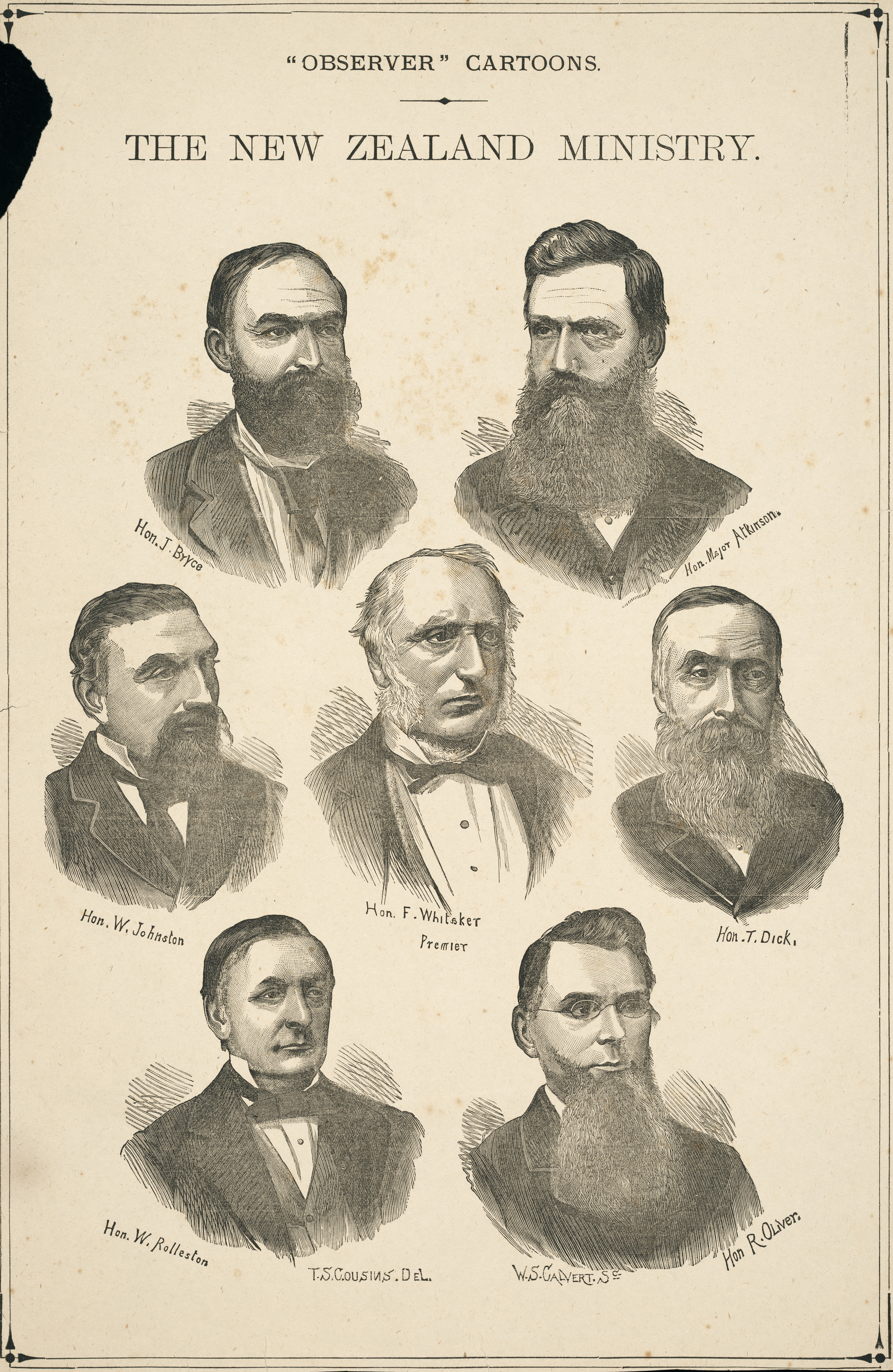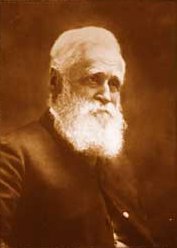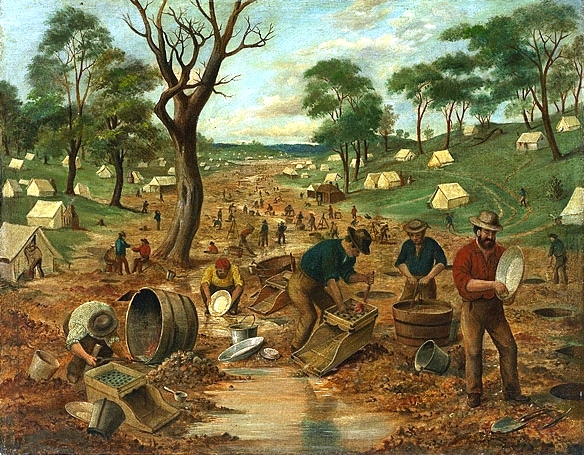|
John Bryce
John Bryce (14 September 1833 – 17 January 1913) was a New Zealand politician from 1871 to 1891 and Minister of Native Affairs from 1879 to 1884. In his attitudes to Māori land questions, he favoured strict legal actions against Māori opposed to alienation, and he personally directed the invasion of Parihaka and the arrest of the leaders of the movement. Described as being stubborn and embittered to Māori questions, Bryce was the public face of a harsh policy towards Māori, but his actions were supported by the Premier and other members of his cabinet. Early life John Bryce arrived in New Zealand as a child in 1840, and had little formal education. After a short time in the Australian gold-fields in 1851, he purchased a farm near Wanganui and remained a farmer for the next fifty years. Early political career In 1859, Bryce started his political career. By 1862 he was representing his area in the Wellington Provincial Council, and by 1866 was the Member of ... [...More Info...] [...Related Items...] OR: [Wikipedia] [Google] [Baidu] |
The Honourable
''The Honourable'' (British English) or ''The Honorable'' (American English; see spelling differences) (abbreviation: ''Hon.'', ''Hon'ble'', or variations) is an honorific style that is used as a prefix before the names or titles of certain people, usually with official governmental or diplomatic positions. Use by governments International diplomacy In international diplomatic relations, representatives of foreign states are often styled as ''The Honourable''. Deputy chiefs of mission, , consuls-general and consuls are always given the style. All heads of consular posts, whether they are honorary or career postholders, are accorded the style according to the State Department of the United States. However, the style ''Excellency'' instead of ''The Honourable'' is used for ambassadors and high commissioners. Africa The Congo In the Democratic Republic of the Congo, the prefix 'Honourable' or 'Hon.' is used for members of both chambers of the Parliament of the Democratic Repu ... [...More Info...] [...Related Items...] OR: [Wikipedia] [Google] [Baidu] |
1871 New Zealand General Election
The 1871 New Zealand general election was held between 14 January and 23 February to elect 78 MPs across 72 electorates to the fifth session of the New Zealand Parliament. 41,527 electors were registered. Background 1871 was the first general election to include the four Māori electorates, with elections held on 1 and 15 February. The first Māori Members of Parliament had been elected in 1868, but in 1871 three retired and one (Western Maori) was defeated. So in 1871 four new Māori MPs were elected. In 1866 the secret ballot was introduced for general (European) elections. The 1871 general election was the first one at which it was used. The secret ballot not used in Māori electorates until 1938, thus Māori voters continued to inform a polling officer orally of their chosen candidate. The date of election is defined here as the day on which the poll took place, or if there was no contest, the day of nomination. The earliest election day was 14 January 1871. The earliest da ... [...More Info...] [...Related Items...] OR: [Wikipedia] [Google] [Baidu] |
1882–1883 Whitaker Ministry
The Whitaker Ministry was formed in 1882 as the government of New Zealand. It was led by Frederick Whitaker and lasted for 17 months, from 21 April 1882 to 25 September 1883. The Whitaker Ministry succeeded the Hall Ministry upon John Hall's resignation. Background John Hall resigned as Premier due to health issues and a Cabinet conflict with Native Minister John Bryce, which led Governor Gordon to attempt to call Sir George Grey to form a Ministry. Hall reminded the Governor that his following held a majority in the House of Representatives and nominated Frederick Whitaker to replace him. Whitaker had been the Hall Government's representative in the Legislative Council, renowned as “a Triton among minnows” in that house. Harry Atkinson represented Whitaker in the lower house. The Ministry succeeded Hall's retrenching government, but as a Budget surplus had been achieved, they felt able to reduce the property tax by half and raise a 3 million pound loan for Public Works. Atk ... [...More Info...] [...Related Items...] OR: [Wikipedia] [Google] [Baidu] |
Arthur Hamilton-Gordon
Arthur Charles Hamilton-Gordon, 1st Baron Stanmore (26 November 1829 – 30 January 1912) was a British Liberal Party politician and colonial administrator. He had extensive contact with Prime Minister William Ewart Gladstone. Career Gordon was born in London in 1829. He was the youngest son of George Hamilton-Gordon, 4th Earl of Aberdeen and his second wife, Harriet Douglas. His mother was the widow of Viscount Hamilton. Gordon was educated privately and then at Trinity College, Cambridge, where he was President of the Cambridge Union Society in 1849. After graduating in 1851, he worked as Assistant Private Secretary to the British Prime Minister (his father) between 1852 and 1855, and was a Member of Parliament (MP) for Beverley from 1854 to 1857. In 1875, the Fiji Islands were created a separate Colony, and Sir Arthur Gordon was appointed the first Governor and Commander-in-Chief of Fiji, until 1880. In connection with this he also received the appointment of Consul-Gene ... [...More Info...] [...Related Items...] OR: [Wikipedia] [Google] [Baidu] |
George William Rusden
George William Rusden (9 July 1819 – 23 December 1903) was an English-born historian, active in Australia. Early life Rusden was born in Leith Hill Place (near Dorking), Surrey, England, son of the Rev. George Keylock Rusden, M.A. (1784-1859) and his wife Anne, ''née'' Townsend. G.K. Rusden was a polyglot and mathematician who kept a private school for 23 years in Surrey before migrating with his family to New South Wales where he was appointed a chaplain at Maitland from 1 January 1835.Ann Blainey, Mary Lazarus,Rusden, George William (1819 - 1903), '' Australian Dictionary of Biography'', Vol. 6, MUP, 1976, pp 72-73. Retrieved 23 November 2009 Australia George William Rusden travelled with his family to Australia and befriended Charles Nicholson on the voyage. Rusden was at first employed on the land, and was soon managing properties. At 28 years of age Rusden travelled to China and worked for a time at brother-in-law Ellis Gilman's Canton factory. Rusden visited his broth ... [...More Info...] [...Related Items...] OR: [Wikipedia] [Google] [Baidu] |
Tītokowaru
Riwha Tītokowaru (c. 1823–1888) was a Māori leader in the Taranaki region of New Zealand. Early life Riwha was a subtribal leader (having succeeded his father "Tītokowaru") of the Ngāti Ruanui and Ngāruahine iwi in South Taranaki. A lot of what was accomplished by his father had been wrongly attributed to the son; being events of intertribal warring during his time of preadolescence. There is some mystery about his early life, but he is known to have become a Methodist in 1842 having been baptised and given the name of Hohepa Otene (named after the missionary). He joined the "King Movement" and fought in the First Taranaki War in 1860 and 1861. In 1865 and 1866, British troops conducted a punitive campaign throughout Taranaki, though they were unable to force a decisive result. In 1867, the year was declared by Tītokowaru to be a year of peace, "''the year of the daughters...the year of the lamb''", and he led over 100 of his followers on a peace march during the w ... [...More Info...] [...Related Items...] OR: [Wikipedia] [Google] [Baidu] |
Wellington Province
Wellington Province, governed by the Wellington Provincial Council, was one of the provinces of New Zealand from 1853 until the abolition of provincial government in 1876. It covered much of the southern half of the North Island until November 1858, when Hawke's Bay Province split off, taking about a third of its area. Territory Wellington Province originally covered much of the southern half of the North Island. Its northern boundary was drawn arbitrarily across most of the middle of the island at latitude 39° south to the east coast, just including the entirety of Hawke Bay. North of that line was Auckland Province. The straight-line boundary did not extend right to the west coast, but dipped south to the coast just west of Waverley and short of Patea, allowing for New Plymouth Province (later renamed Taranaki Province) to the west. Hawke's Bay settlers broke away to form Hawke's Bay Province on 1 November 1858. Wellington Province's new eastern boundary followed the main d ... [...More Info...] [...Related Items...] OR: [Wikipedia] [Google] [Baidu] |
1875–1876 New Zealand General Election
The 1875–1876 New Zealand general election was held between 20 December 1875 and 29 January 1876 to elect a total of 88 MPs in 73 electorates to the 6th session of the New Zealand Parliament. The Māori vote was held on 4 and 15 January 1876. A total of 56,471 voters were registered. Background Political parties had not been established yet; this only happened after the 1890 election. The previous parliament had 78 representatives from 72 electorates. In October 1875, Parliament passed the Representation Act 1875, and resolved to increase the size of Parliament to 88 representatives through the following changes: * one additional member for City of Dunedin (from two to three) * the single member electorates of Christchurch East and Christchurch West to amalgamate and form the City of Christchurch electorate with three members * one additional member for Timaru ( was formed as a new electorate) * one additional member for Waitaki (from one to two) * one additional member ... [...More Info...] [...Related Items...] OR: [Wikipedia] [Google] [Baidu] |
Australian Gold-fields
During the Australian gold rushes, starting in 1851, significant numbers of workers moved from elsewhere in Australia and overseas to where gold had been discovered. Gold had been found several times before, but the colonial government of New South Wales (Victoria did not become a separate colony until 1 July 1851) had suppressed the news out of the fear that it would reduce the workforce and so destabilise the economy. After the California Gold Rush began in 1848, many people went there from Australia, so the New South Wales government sought approval from the British Colonial Office for the exploitation of mineral resources, and offered rewards for finding gold. History of discovery The first gold rush in Australia began in May 1851 after prospector Edward Hargraves claimed to have discovered payable gold near Orange, at a site he called Ophir. Hargraves had been to the Californian goldfields and had learned new gold prospecting techniques such as panning and cradling. H ... [...More Info...] [...Related Items...] OR: [Wikipedia] [Google] [Baidu] |
Ministry For Culture And Heritage
The Ministry for Culture and Heritage (MCH; ) is the department of the New Zealand Government responsible for supporting the arts, culture, built heritage, sport and recreation, and broadcasting sectors in New Zealand and advising government on such. History The Ministry of Cultural Affairs had been created in 1991; prior to this, the Department of Internal Affairs (DIA) had provided oversight and support for arts and culture functions. MCH was founded in 1999 with the merger of the former Ministry of Cultural Affairs and the history and heritage functions of the DIA, as well as some functions from the Department of Conservation and Ministry of Commerce. The purpose of the merger of functions and departments was to create a coherent, non-fragmented overview of the cultural and heritage sector, rather than spreading services and functions across several departments. Minister for Cultural Affairs Marie Hasler oversaw the transition of functions into the new agency. Opposition La ... [...More Info...] [...Related Items...] OR: [Wikipedia] [Google] [Baidu] |
Te Ara - The Encyclopedia Of New Zealand
''Te Ara: The Encyclopedia of New Zealand'' is an online encyclopedia established in 2001 by the New Zealand Government's Ministry for Culture and Heritage. The web-based content was developed in stages over the next several years; the first sections were published in 2005, and the last in 2014 marking its completion. ''Te Ara'' means "the pathway" in the Māori language, and contains over three million words in articles from over 450 authors. Over 30,000 images and video clips are included from thousands of contributors. History New Zealand's first recognisable encyclopedia was ''The Cyclopedia of New Zealand'', a commercial venture compiled and published between 1897 and 1908 in which businesses or people usually paid to be covered. In 1966 the New Zealand Government published ''An Encyclopaedia of New Zealand'', its first official encyclopedia, in three volumes. Although now superseded by ''Te Ara'', its historical importance led to its inclusion as a separate digital reso ... [...More Info...] [...Related Items...] OR: [Wikipedia] [Google] [Baidu] |






